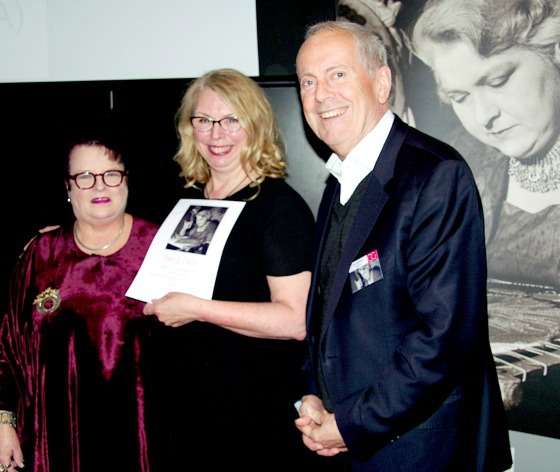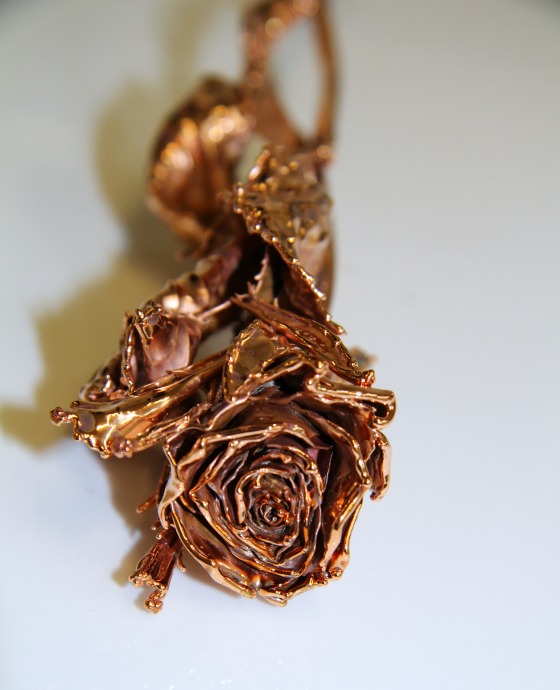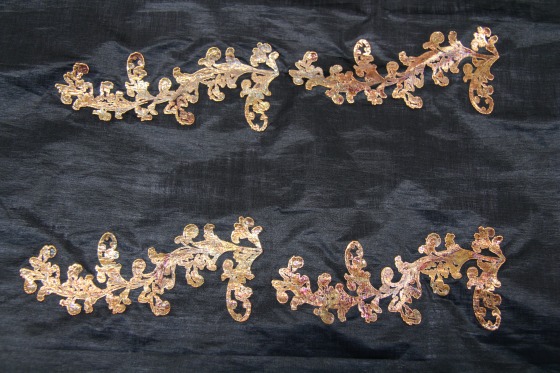Cutting-edge research into growing metal on objects has earned an award-winning De Montfort University Leicester (DMU) academic a spotlight during the BBC’s Royal Collection season.

Horton (middle) receiving the Embroiderers’ Guild Beryl Dean Award for Teaching Excellence in Embroidery and Design for 2017
The range of programming telling the fascinating history of one of the most important art collections in the world – the Royal Collection – includes a four-part BBC Four series featuring DMU senior lecturer in Textile Design Jo Horton.
Episode three of Art, Passion & Power: The Story of the Royal Collection sees Horton demonstrating the process of electroforming copper to presenter Andrew Graham-Dixon, by attracting the metal onto a real rosebud using a conductive medium, electric current and an electrolyte solution.
Horton said: “Electroforming is a process where metal objects or coatings can be ‘grown’ in a tank to a wide range of thicknesses from a few microns to centimetres thick. I like to call it ‘metal horticulture’.”

Horton electroformed rosebuds in preparation for her TV debut
Airing at 9pm on Tuesday 30 January, the episode delves further into the extraordinary art and decorative objects collected by kings and queens over the last 500 years, including those accumulated by Queen Victoria and Prince Albert, for whom collecting was a key part of their marriage.
RELATED NEWS
Discover what DMU has to offer at our next Open Day
Abandoned architecture designs earn Kashmal coveted award
Applying chemistry to embroidery earns recognition for DMU textiles academic
“Prince Albert believed that learning how to make art was the best way to understand it and to appreciate its value, which was a very modern way of thinking back then and something that’s inspired me since learning about it,” said Horton.
“He became interested in a process similar to electroforming when he was presented with an electro-gilded rosebud in 1843 by Elkington & Co., a successful silver manufacturer founded in Birmingham in the 1830s.
“It was such an honour to be a part of this series and to demonstrate what was a highly regarded skill during the Victorian era, often referred to as a ‘dark art’, which has now been developed for many uses in manufacturing and engineering.”

An example of Horton's innovative copper embroidery
Horton, who for seven years has been researching the use of electric currents and copper to develop a new type of embroidery, was filmed at the School of Jewellery at Birmingham City University, which is where she conducted much of her PhD work.
She said: “Being filmed for such an important programme and getting to work with Andrew Graham-Dixon was an amazing experience.
“As someone from the Black Country, being part of something routed in the West Midlands is very exciting. It’s important to recognise the creativity and innovation of people from this part of the country in this area, and it has very personal appeal for me.
“I am also forever grateful to my scientific advisor and expert in electroforming, Mr Leslie Curtis.”
Posted on Tuesday 23 January 2018